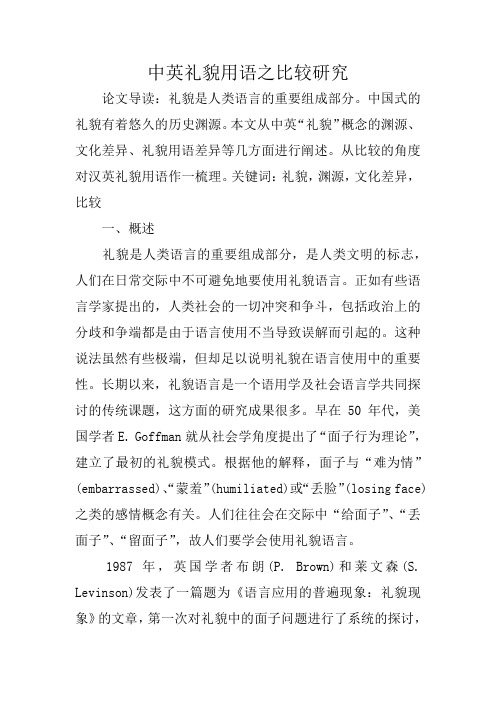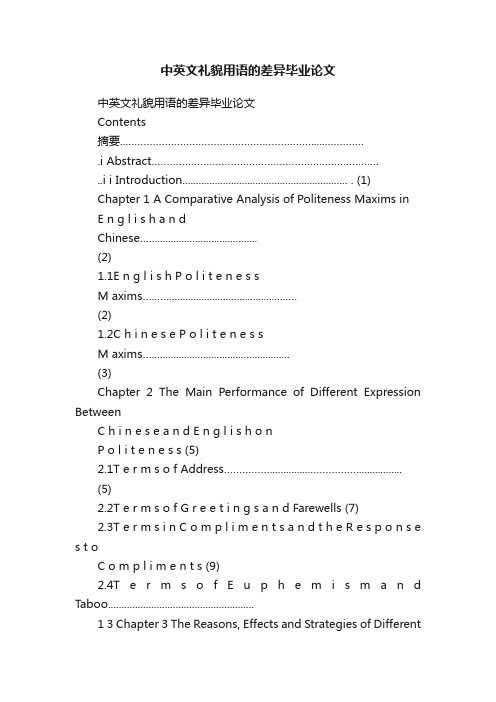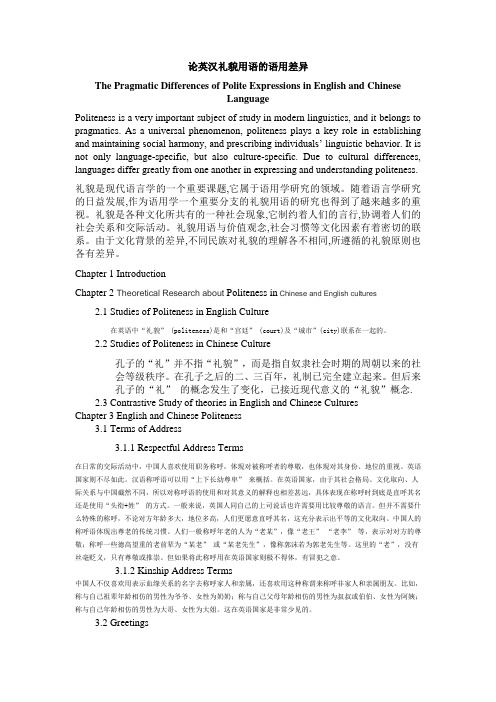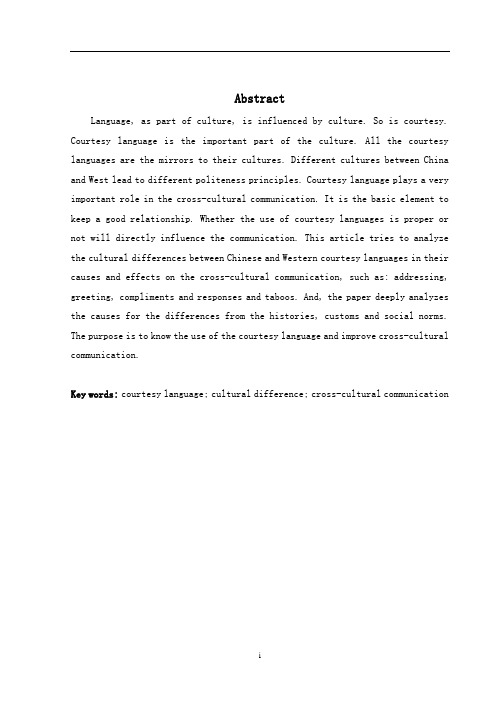(英语毕业论文)英汉礼貌用语的对比研究
从礼貌原则上看中西委婉语的差异毕业论文含开题报告

本科生毕业论文(设计)题目:Comparison of English and Chinese EuphemismBased on the Politeness Principle从礼貌原则上看中西委婉语的差异系别:外国语言文学系专业:英语AbstractAlong with the continuous development of globalization, the communications between China and western countries have been increasing gradually in economy, politics and culture. More and more of us are required to understand people coming from countries and cultures different from our own, so the impact of difference between Oriental and Occidental cultures on international trade becomes increasingly exposed. In the cross-culture communication, we can not be ignorant of the differences between English and Chinese euphemism.In addition, p oliteness is the symbol of human culture and society’s universal phenomenon. However, the different cultures has different politeness principle which does not use to weigh the standard as well as the expression way. Learning the different usages of English and Chinese euphemisms based on the politeness principle aims at pointing out that people can put the euphemisms into right usage only if people understand correctly different cultures. Only in this way, we can avoid some mistakes, misunderstanding or even conflicts. Thus, we can promote the cross-cultural communication going effectively and to be in the best condition.This paper aims at discussing the differences between English and Chinese euphemisms that are faced in today's international communication and evolving appropriate measures to deal with those. It consists of four parts, with an introduction and a conclusion preceding and following them. As euphemism is a linguistic phenomenon, chapter two first states the origin and the definition of the euphemism, and the analysis of the obedience of the English and Chinese politeness principle, thus building up a better understanding of euphemism. Chapter three illustrates the differences of English and Chinese euphemism and discusses the factor forthe differences. All of these can help people to avoid pragmatic failures in communication.Key Words: Euphemism,Politeness Principle,Contrastive Analysis毕业设计(论文)原创性声明和使用授权说明原创性声明本人郑重承诺:所呈交的毕业设计(论文),是我个人在指导教师的指导下进行的研究工作及取得的成果。
中英礼貌用语之比较研究

中英礼貌用语之比较研究论文导读:礼貌是人类语言的重要组成部分。
中国式的礼貌有着悠久的历史渊源。
本文从中英“礼貌”概念的渊源、文化差异、礼貌用语差异等几方面进行阐述。
从比较的角度对汉英礼貌用语作一梳理。
关键词:礼貌,渊源,文化差异,比较一、概述礼貌是人类语言的重要组成部分,是人类文明的标志,人们在日常交际中不可避免地要使用礼貌语言。
正如有些语言学家提出的,人类社会的一切冲突和争斗,包括政治上的分歧和争端都是由于语言使用不当导致误解而引起的。
这种说法虽然有些极端,但却足以说明礼貌在语言使用中的重要性。
长期以来,礼貌语言是一个语用学及社会语言学共同探讨的传统课题,这方面的研究成果很多。
早在50年代,美国学者E. Goffman就从社会学角度提出了“面子行为理论”,建立了最初的礼貌模式。
根据他的解释,面子与“难为情”(embarrassed)、“蒙羞”(humiliated)或“丢脸”(losing face)之类的感情概念有关。
人们往往会在交际中“给面子”、“丢面子”、“留面子”,故人们要学会使用礼貌语言。
1987年,英国学者布朗(P. Brown)和莱文森(S. Levinson)发表了一篇题为《语言应用的普遍现象:礼貌现象》的文章,第一次对礼貌中的面子问题进行了系统的探讨,因而引起了语言学界的极大关注。
他们把它分成积极面子和消极面子两种:前者指人们期望自己的言行、思维等得到肯定和赞赏,后者指人们希望在交际活动中自己的自由不受侵犯。
这样,礼貌也就随之分为积极礼貌和消极礼貌。
20世纪80年代,英国语言学家利奇(G. Leech)从语用学的角度对交际活动中的礼貌原则重新进行了归纳和分类,认为礼貌原则由得体、慷慨、赞誉、谦虚、一致和同情等六个准则构成。
利奇的礼貌原则注意自身并尊重他人,二者兼顾,更符合言语交际的本质。
中国是文明古国,礼仪之邦,中国式的礼貌有着悠久的历史渊源。
自古就有“一言而兴邦,一言而丧邦”的说法。
中英文礼貌用语的差异毕业论文

中英文礼貌用语的差异毕业论文中英文礼貌用语的差异毕业论文Contents摘要...……………………………………………………......………….i Abstract……………………………………………….……….….……..i i Introduction............................................................. . (1)Chapter 1 A Comparative Analysis of Politeness Maxims inE n g l i s h a n dChinese…........................................(2)1.1E n g l i s h P o l i t e n e s sM axims…..….............................................…(2)1.2C h i n e s e P o l i t e n e s sM axims…...................................................(3)Chapter 2 The Main Performance of Different Expression BetweenC h i n e s e a n d E n g l i s h o nP o l i t e n e s s (5)2.1T e r m s o f Address……………...............…………….................(5)2.2T e r m s o f G r e e t i n g s a n d Farewells (7)2.3T e r m s i n C o m p l i m e n t s a n d t h e R e s p o n s e s t oC o m p l i m e n t s (9)2.4T e r m s o f E u p h e m i s m a n d Taboo......................................................1 3 Chapter 3 The Reasons, Effects and Strategies of DifferentE x p r e s s i o nB e t w e e nC h i n e s e a n d E n g l i s h o nP o l i t e n e s s (18)3.1 The Reasons of Different Expression Between Chinese andE n g l i s ho n Politeness.............................................(18)3.2 The Influence of the Different Expression Between Chinesea n dE n g l i s h o n Politeness................................................. ......................2 23.3 The Strategies to the Different Expression Between Chinesea n dE n g l i s h o nPoliteness................................................. ......................2 4 Conclusion.................................................................... .......2 6 Bibliography............................................................... .. . (27)AcknowledgementIntroductionWhen we communicate with other people, we have to obey a lot of rules of manners which have rooted in our daily life. If not, there would appear many misunderstandings. Every nation has its politeness. People use different politeness language in different situations. And we can say politeness language plays an important role in our communication with people around us.People from different countries may have different manners,thus they could encounter difficulties in their communication. As the development of our country, the internationalism is becoming more and more rapidly. We need to communicate with people of the world. But they have their own attitudes towards things which maybe a little bit different or totally different from ours. If we do not understand the cultures of them, absolutely, we will have a lot of difficulties in this process. Sometimes, we are likely to understand one thing in our own perspective. Today, a better understanding of people who come from other cultures is very important. Especially in the cross-culture communication. This article is written tointroduce the different expression between Chinese and English on politeness from different perspectives.Chapter 1A Comparative Analysis of Politeness Maxims in Englishand ChineseIn the past decades, researchers focused on the politeness principle as an important pragmatic principle. The function of politeness, as a social phenomenon, is maintaining social order, reducing conflicts and misunderstanding in communications. We can make our behavior polite with the help of some politeness maxims, such as Cr ice’s Cooperative Principle, Leech’s politeness principles and Gu Yueguo’s politeness principles.1.1 English Politeness MaximsAmong the principles proposed by pragmaticists to explain the phenomena in the use of language in conversation, Crice’s Cooperative Principle is one of the basic ones. But Leech thinks that it fails to explain all the phenomena in language use, especially fails to explain why people tend to use many indirect speech acts to violate Cooperative Principle, so he puts forwardthe Politeness Principle. Here are his six politeness maxims.(1)T act Maxim: It means minimize cost and maximize benefit toothers.(2)G enerosity Maxim: It means minimize benefit and maximizecost to selfs.(3)A pprobation Maxim: It means minimize dispraise and maximizepraise of others.(4)M odesty Maxim: It means minimize praise and maximizedispraise of self.(5)A greement Maxim: It means minimize disagreement betweenself and others while maximize agreement between self and others.(6)S ympathy Maxim: It means minimize antipathy between self andothers while maximize sympathy between self and other.1.2 Chinese Politeness MaximsIn China, the real study of politeness only began in the 1980s when pragmatics was introduced into China. The most important figure in this area is Gu Yueguo. He is a student of Leech and comes from Beijing Foreign Studies University. On the basis of Chinese culture, Gu used L eech’s principle of politeness for reference and summed up four features of Chinese politeness, and later developed them into five politeness。
论英汉礼貌用语的语用差异

论英汉礼貌用语的语用差异The Pragmatic Differences of Polite Expressions in English and ChineseLanguagePoliteness is a very important subject of study in modern linguistics, and it belongs to pragmatics. As a universal phenomenon, politeness plays a key role in establishing and maintaining social harmony, and prescribing individuals’ linguistic behavior. It is not only language-specific, but also culture-specific. Due to cultural differences, languages differ greatly from one another in expressing and understanding politeness.礼貌是现代语言学的一个重要课题,它属于语用学研究的领域。
随着语言学研究的日益发展,作为语用学一个重要分支的礼貌用语的研究也得到了越来越多的重视。
礼貌是各种文化所共有的一种社会现象,它制约着人们的言行,协调着人们的社会关系和交际活动。
礼貌用语与价值观念,社会习惯等文化因素有着密切的联系。
由于文化背景的差异,不同民族对礼貌的理解各不相同,所遵循的礼貌原则也各有差异。
Chapter 1 IntroductionChapter 2 Theoretical Research about Politeness in Chinese and English cultures2.1 Studies of Politeness in English Culture在英语中“礼貌” (politeness)是和“宫廷” (court)及“城市”(city)联系在一起的。
中西礼貌用语的语用对比研究

最新英语专业全英原创毕业论文,都是近期写作1 《京华烟云》中姚木兰和《飘》中斯嘉丽的性格对比2 A Comparative Analysis of English V ocabulary Teaching between China and America at the Primary and Secondary School Level3 A Comparative Study on Two Chinese Versions of Percy Bysshe Shelley’s Ode to The West Wind4 礼貌策略在商务信函中的应用5 An Analysis of Beauty and Ugliness in The Picture of Dorian Gray of Oscar Wilde6 论广告英语的修辞特征及其翻译7 《罗密欧与朱丽叶》和《牡丹亭》中女性主义意识的对比研究8 《最蓝的眼睛》中美国黑人小女孩所承受的三重歧视9 分析戴珍珠耳环的少女10 汤姆叔叔的小屋中汤姆形象分析1112 论凯瑟琳﹒曼斯菲尔德作品中的彼得﹒潘情结13 浅析《了不起的盖茨比》中的美国梦14 A Comparison of the English Color Terms15 浅析初中生英语写作问题及对策16 从跨文化交际角度看《贵妇画像》中的文化冲突17 A Comparative Study Between the Novel To Kill A Mockingbird and Its Film Adaptation18 《了不起的盖茨比》叙述者尼克分析19 浅谈英语颜色词汇的象征意义20 对美国个人主义和中国集体主义的一些讨论21 English to Chinese Translation Methods22 小说《珍珠》中象征主义的运用23 中西跨文化交际中非语言行为的比较研究24 On Contradiction Between Comprehension and Expression in Translation25 礼貌原则在英汉语言文化差异中的应用26 分析汉英篇章衔接和意合形合的关系27 论童话《小王子》的象征创作28 中美教育的比较及对比29 不同的音乐折射不同的文化30 从高中生生理和心理的角度探讨PPT使用的利弊31 简•奥斯丁的婚姻观在《傲慢与偏见》中的体现32 An Analysis of The Bible’s Influence on British and American Literature33 从翻译美学角度谈化妆品商标词的翻译34 英语复合名词的认知语义研究35 探究哈利波特的英雄成长之路36 广告英语的翻译37 二语习得理论对初中英语教学的启示刍议38 The Blindness in King Lear39 东西方人名文化与翻译—以英汉人名为例40 An Analysis of the Tragic Fate of Mary Turner in The Grass Is Singing41 高中英语写作作业的反馈及实施效果42 英汉味觉词“酸甜苦辣”的比较分析43 欧•亨利短篇小说的特点44 如何提高小学生对英语学习的兴趣45 外交辞令中模糊语言的语用分析46 从思维方式看中英科普文章的差异47 英语听力理解障碍及应对策略48 浅谈在华跨国公司的本土化策略49 Influences of Chinese Classical Poetry on Ezra Pound50 现代信息技术与英语学科教学的有效整合51 剖析简•爱性格的弱点52 Comparison of models of Human Resource Management between East and West53 从“进步”话语解读《苔丝》中环境因素与人物性格54 从莎翁作品透视伊丽莎白时期女性社会地位55 英汉禁忌语的对比分析56 从《了不起的盖茨比》看美国梦的幻灭57 《圣经》对英语习语的影响58 《圣经》与人类文明起源59 英汉恐惧隐喻对比研究60 英语财经报道中的词汇衔接研究61 勃朗特两姐妹创作风格差异探究62 从《通往雨山之路》看美国印第安文化的逐渐衰落63 从语用学角度对英语课堂中委婉语的使用探究64 批评与重新解读《日瓦戈医生》65 英汉动物习语内涵意义的文化差异66 中英语言中动物词汇的文化含义对比67 浅析英语粘着词素及其在词汇教学中的实用价值68 On“Faithfulness, Expressiveness, Elegance” in Translation of Business Contract69 Terror of the Soul-An alysis of Features in Poe’s Gothic Fictions70 浅析英语谚语中的女性歧视71 论《荆棘鸟》中人性和宗教信仰的矛盾冲突72 A Comparison of the English Color Terms73 从合作原则角度简要分析《老友记》中乔伊的性格特征74 英汉委婉语中体现的文化异同75 英汉数字习语的翻译76 初中英语教学中的角色扮演77 英语汉源借词研究78 林黛玉和简.爱不同命运的对比79 从电视相亲节目看当代中美女性婚恋观差异80 简爱的独立与反叛性格分析81 从《红字》看霍桑对清教主义的批判与妥协82 从约翰邓恩的“奇思妙喻”中透视他矛盾的情感观83 论隐喻的本质与功能84 英语动画片中的中国元素探究85 中西方新闻报道看道德观差异86 论地理位置对中美民族性格的影响87 华裔美国文学中的幽灵叙事探析88 Reconstruction of Black Identity in Toni Morrison’s Beloved89 《永别了,武器》的意象分析90 礼貌原则在英语商务信函中的运用91 歇斯底里的舞台自语者——《寻找格林先生》主题解读92 论修辞在英语广告中的应用93 社会因素对汉语中英语外来词的影响94 Domestication and Foreignization in Idioms Translation95 《道连葛雷的画像》叙事艺术的分析96 从语言角度分析《功夫熊猫》中中西文化的交融97 从英汉习语视角看中英文化差异98 简爱中的批判现实主义和浪漫主义99 传统教法与交际法结合的英语教学探讨100 沃尔玛策略研究101 解析凯瑟琳的爱情与婚姻之分离102 从《印度之行》看福斯特的人文主义思想观103 企业网络营销策略分析104 英汉禁忌语对比研究105 跨文化交际中的语用失误及其对策106 安吉尔的精神悲剧—分析哈代笔下人物的心理发展过程107 词汇教学法在中学英语教学实践中的应用108 从关联理论看《阿甘正传》的字幕翻译109 论《被遗弃的韦瑟罗尔奶奶》中象征主义和意识流的运用110 《紫色》中的女性主义解读111 The Pervasive Agitation of Humbert in Lolita112 《等待戈多》中的矛盾分析-分裂的语言与互补的人物113 语用策略在英语商务信函中的应用114 中英文新闻标题的差异115 《哈克贝利•费恩历险记》的艺术特色分析116 中西方家庭教育对比研究——从《傅雷家书》和《致儿家书》的对比117 从目的论角度分析化妆品品牌翻译118 从目的论角度分析商业电视广告中双关语的翻译119 古诗词英译关于夸张的翻译策略研究120 从功能翻译理论看汉语公示语的英译121 《呼啸山庄》男主人公希斯克里夫的性格分析122 伯莎梅森形象分析123 浅析亨利•詹姆斯小说《螺丝在拧紧》中的哥特成分124 苔丝悲剧的原因与托马斯哈代悲剧意识的分析125 On C-E Translation of Neologisms from the Perspective of Nida’s Functional Equivalence Theory126 英汉基本颜色词的文化差异及其翻译策略127 从文化差异的四维度读解中法葡萄酒文化128 Angel’s Face, Devil’s Heart—The Degeneration of Dorian Gray in The Picture of Dorian Gray129 谈电影片名的翻译130 《夜访吸血鬼》中的模糊性别观131 Irony Art in Orwell’s Animal Farm132 An Analysis on Shear's Personality in The Bridge on the River Kwai133 A Comparative Analysis of Vanity Fair and Great Expectations134 浅析田纳西•威廉斯剧作《欲望号街车》的同性恋倾向135 浅析《了不起的盖茨比》中的主要人物性格136 多元智力发展与外语教学137 《诗经》与《圣经•雅歌》中爱情诗的比较研究138 互动在高中英语阅读课的应用139 论《觉醒》中艾德娜女性意识的觉醒140 A Feminist Reading of Virginia Woolf and A Room of One’s Own141 初中英语词汇教学法研究综述142 论《喧哗与躁动》中的女性形象143 试析中英婚姻生活差异及其原因144 广告英语及其翻译145 Application of Foregrounding Theory to Translation of Simile and Metaphor146 On Feminism in Persuasion147 《老人与海》的主题解析148 浅析《看不见的人》中看得见的种族歧视149 商务英语翻译中的隐喻研究150 英语广告语篇中名物化的研究151 福克纳小说《献给艾米莉的玫瑰》的叙事技巧研究152 中餐菜谱翻译的错误分析153 浅论广告英语的修辞特色154 《罗密欧与朱丽叶》中双关语的研究155 《达洛卫夫人》与弗吉尼亚•伍尔夫的女性主义156 论视觉小说中的西方神话形象重塑——以《命运之夜》系列为例157 从浪漫主义角度剖析《海上钢琴师》在中国流行的原因158 中英爱情隐喻的对比研究159 从归化与异化之争看四字格的运用160 从模因论视角看年度流行语“给力”161 高中英语反思式教学研究162 斯佳丽,在逆境中成长163 英汉恭维语的对比研究164 《了不起的盖茨比》中的象征主义解读165 论《老人与海》中圣地亚哥性格的双重性166 中西方节日文化差异研究167 山寨文化的反思——发展与创新168 浅议创新型口语教学在农村中的实施169 试论英语词汇教学中的词块教学170 论中美商务沟通中的跨文化意识171 霍桑在《红字》中对人的罪恶的探究172 The English Translating of Chinese Neologisms in Political Documentation: Methods and Strategies173 哥特元素在《宠儿》中的运用174 《查特莱夫人的情人》中肉体与灵魂的平衡175 化学专业学生英语阅读策略研究176 八十年代以来汉语中英语外来语及翻译177 浅谈电影台词的翻译技巧--以《追求幸福》为例178 文化语境对中西商务谈判的影响179 谈《傲慢与偏见》中伊丽莎白的女性主体意识180 A Summary of Symbols of The Scarlet Letter181 小学英语语音拼读教学182 中国时政新词翻译探析183 论《紫色》中西莉的精神意识的创建184 论《麦田里的守望者》的意义185 从《生活的艺术》看林语堂的人生艺术186 Culture-based Strategies in Translating Ancient Chinese Official Titles187 浅析《傲慢与偏见》中伊丽莎白的性格和婚姻观188 商务英语函电的语言和文体特征及其翻译189 从模因论角度研究中文新闻标题中的流行语190 中西礼貌用语的语用对比研究191 从翻译美学角度谈汽车商标词的汉译192 报刊英语新词的汉译193 Advertising Language: A Mirror of American Value194 生存危机和渴求改变——黑色幽默小说的主体研究195 简与林黛玉性格及命运对比196 苔丝悲剧人生的起因197 文化背景知识在英语教学中的作用198 以学生为中心的英语词汇教学研究199 <<罗伯特家的苔丝>>中动植物的作用200 英美小说《傲慢与偏见》和《飘》中的女性主体意识比较分析。
英汉礼貌原则对比分析,英语其它论文

英汉礼貌原则对比分析,英语其它论文A Comparative Study of Politeness Principle in Chinese and English Culture[Abstract] As we all know, different people hold different views about politeness and different cultures may lead to pragmatic differences. Because of the cultural differences, sometimes what the Chinese people consider to be polite may not be true according to western culture. To be polite, there are some principles to follow, such as H. P. Grice’s Cooperative Principle, Geoffrey N. Leech’s Politeness Principle, and in China, there are Prof. Gu Yueguo’s five notions of politeness based on the Chinese conception of limao. This paper briefly describes these principles, and also makes a comparative study on Politeness Principle in Chinese and English cultures. Besides, this paper also attempts to shed light on some of the pragmatic differences on politeness between Chinese and western cultures, indicating that typical Chinese and English politeness principles are similar to each other in nature but the differences between them are also playing a significant role in intercultural speech interaction. At the end, this paper analyses another maxim—Culture Self-identity Maxim, and indicates that grammatical mistakes in intercultural communication can be forgiven, but improper use of language can often cause misunderstandings and embarrassments. So the comparative study of Politeness Principle in Chinese and English cultures becomes more important. Meanwhile, to be familiar with the different cultural backgrounds and to choose the right politeness maxims during communication are also very important.[Key Words] politeness; politeness principle; pragmatics differences; intercultural communication英汉礼貌原则对比分析【摘要】众所周知,不同的人对礼貌持有不同的观点,而不同的文化又会导致语用差异。
试论英汉礼貌用语之比较

试论英汉礼貌用语之比较摘要】本文根据Leech提出的英语文化的礼貌原则和顾曰国先生提出的汉文化的礼貌原则,进行对比研究,并就英汉语言的文化差异和礼貌语言策略进行分析,最后,阐述了这一研究对跨文化交际的重要性。
【关键词】文化差异;礼貌原则;语言策略On the English language courtesy ComparisonXu Chuying【Abstract】This article made in accordance with Leech’s Politeness Principle in English culture and to Mr. Gu Yueguo courtesy of the Chinese culture the principle of comparative studies, and cultural differences between English and Chinese language and politeness strategy analysis, and finally, on the study of the importance of cross-cultural communication.【Key words】Cultural differences Politeness Principle Language Strategy礼貌作为人类文明的体现,它不仅是一种社会现象,也是语言现象。
随着跨文化交际研究的迅速发展,不同文化中礼貌的概念与内涵在跨文化交际中如何做到礼貌得体,越来越引起人们的关注。
由于人们对什么是礼貌和怎样做才是有礼貌持有不同观点,因而常常能导致交际失误乃至失败,因此,对礼貌现象,特别是跨文化交际中英汉两种语言所体现的礼貌现象进行比较是非常必要的。
本文对英汉礼貌现象从理论基础到其表现形式进行了比较性地研究。
本文试图综述中西方言语行为中礼貌语言文化差异及语言策略差异,给跨文化研究中讲英语与讲汉语的人遵守彼此的“礼貌原则”,达到相互沟通提供一点启示。
英语专业毕业论文--从礼貌用语看中西文化差异

AbstractLanguage, as part of culture, is influenced by culture. So is courtesy. Courtesy language is the important part of the culture. All the courtesy languages are the mirrors to their cultures. Different cultures between China and West lead to different politeness principles. Courtesy language plays a very important role in the cross-cultural communication. It is the basic element to keep a good relationship. Whether the use of courtesy languages is proper or not will directly influence the communication. This article tries to analyze the cultural differences between Chinese and Western courtesy languages in their causes and effects on the cross-cultural communication, such as: addressing, greeting, compliments and responses and taboos. And, the paper deeply analyzes the causes for the differences from the histories, customs and social norms. The purpose is to know the use of the courtesy language and improve cross-cultural communication.Key words: courtesy language; cultural difference; cross-cultural communication摘要语言既是文化的载体,又是文化的一部分,语言受到文化的影响,是文化的一面镜子。
- 1、下载文档前请自行甄别文档内容的完整性,平台不提供额外的编辑、内容补充、找答案等附加服务。
- 2、"仅部分预览"的文档,不可在线预览部分如存在完整性等问题,可反馈申请退款(可完整预览的文档不适用该条件!)。
- 3、如文档侵犯您的权益,请联系客服反馈,我们会尽快为您处理(人工客服工作时间:9:00-18:30)。
最新专业原创毕业论文,都是近期写作1 A Study on Differences of Family Education between China and America--A Case Study of The Joy Luck Club2 论简奥斯丁在《傲慢与偏见》中的女性意识和婚姻观3 对林语堂的《吾国与吾民》几种中译本比较研究4 生态哲人约翰斯坦贝克5 从家庭伦理关系视角解读《儿子与情人》的女性主义6 论报刊语言翻译中的译者主体性7 凯特肖邦作品中女性自我意识觉醒的主题研究8 商务英语信函中的礼貌原则9 《紫色》中“家”的解读10 从电影《七宗罪》看‘七宗罪’与基督教传统的关系11 基于微博(推特)文化的新型营销模式12 Bertha Is Jane:A Psychological Analysis of Charlotte Bronte’s Jane Eyre13 爵士时代下的狂欢化精神——解析豪华宴会在《了不起的盖茨比》中的写作手法以及作用14 外来词的翻译方法初探15 中文古诗词叠词的研究与翻译16 文类、历史与受众心态——论小说《红字》的电影改编17 电影名称的翻译特点18 浅析中美商务谈判中的文化冲突19 中西方鬼怪比较研究20 汉英“眼”概念隐喻的对比研究21 从僵尸和吸血鬼比较中西方文化的异同22 法律英语翻译中的动态对等理论分析23 浅论《汤姆琼斯》的现实主义特征24 从《法国中尉的女人》看约翰福尔斯的女性主义思想及其局限性25 从功能对等理论谈中国小吃名英译26 简奥斯丁的女权主义在《理智与情感》中的体现27 海明威短篇小说的叙述艺术--以《一个明亮干净的地方》为例28 从叔本华的哲学思想角度简析《德伯家的苔丝》中苔丝的悲剧29 中英文颜色词的非对应翻译30 英语抽象名词和物质名词的数概念分析31 《雾都孤儿》中的批判现实主义32 女性主义解读《傲慢与偏见》中的柯林斯33 《玻璃动物园》中的逃避主义解读34 论高中英语文化教学35 论翻译的艺术36 英汉职业委婉语中“礼貌原则”之对比分析37 《王尔德童话故事》的翻译美学探析38 《了不起的盖茨比》和《太阳照常升起》中时髦女郎的对比39 Elements on the Growth of Mary in The Secret Garden40 不做房间里的天使——解读《爱玛》中的女性主体意识41 纳博科夫小说《洛丽塔》的爱情讽刺42 浅析英语习语的翻译原则和方法43 英语阅读有效教学活动设计研究44 浅谈中学英语教学中的情感教学方法45 商务英语的语用特点及翻译46 从成长小说角度比较研究《哈克贝利费恩历险记》和《麦田里的守望者》47 《三国演义》中带数字的词语翻译研究48 中国和英国传统婚俗差异研究49 美国宪法形成的历史和原因之研究50 The Influence of The New Policy of Export Tax Rebates51 论《拉合尔茶馆的陌生人》中昌盖茨“美国梦”的转变52 浅析隐藏在“面纱”之后的伯莎梅森53 浅谈礼仪在商务谈判中的重要性及其相关策略54 浅析隐藏在“面纱”之后的伯莎梅森55 浅析菲尔丁《弃儿汤姆琼斯史》中的世俗女性形象56 《嘉莉妹妹》时代背景下女性的地位57 论女性的牺牲——对《儿子与情人》中女性形象的分析58 从文化的角度看英语电影片名的翻译59 非传统式英雄——从女性主义批评角度看《名利场》60 论约翰多恩诗歌中的力61 《汤姆叔叔的小屋》中圣克莱尔一家的人物分析62 社会语言学视角下女性语言的特点63 从爱情观的转变谈《飘》中斯嘉丽的成长历程64 A Comparison of the English Color Terms65 西方电影片名翻译的功能目的论分析66 The Features of Classic-literature-based Movies Showed in Pride and Prejudice67 黑人社区的替罪羊--论托尼莫里森《最蓝的眼睛》中的黑人小女孩佩科拉68 海明威小说硬汉形象的悲剧色彩69 从跨文化的角度研究故事影片名字的英汉翻译70 英汉“悲伤”情感隐喻认知对比分析71 从奈达功能对等理论谈继宏译《追风筝的人》72 分析托马斯哈代对西奥多德莱塞的文学影响73 试析英语广告中双关语的翻译74 浅析隐藏在“面纱”之后的伯莎梅森75 《玻璃动物园》中的逃避主义解读76 少儿英语学习中的情感因素分析77 浅析隐藏在“面纱”之后的伯莎梅森78 麦克莫波格《柑橘与柠檬啊》的叙事艺术79 从诗歌分析威廉.华兹华斯的人生观和自然观80 从女性主义角度看斯嘉丽与命运的抗争81 论《呼啸山庄》中的象征主义运用82 论《织工马南》中的象征意义83 论杰伊盖茨比之“了不起”84 艾米莉狄金森雏菊诗中的死亡观85 浅谈提高高中生英语写作能力的途径86 浅谈公示语的翻译87 从多视角比较《论读书》的两个译本88 模糊语在国际商务谈判中的语用功能研究89 英语电影片名翻译微探90 Situational Approach to Grammar Teaching in Senior High English Classes91 用合作原则和礼貌原则分析网络聊天室会话的含义92 量词“片”与“piece”的语法化对比研究93 从《草原日出》看多丽丝莱辛的成长观94 苔丝悲剧原因探究9596 科技英语中名物化的功能97 女性意识的觉醒——评《雨中的猫》中的人物对比描写98 《玻璃动物园》中的逃避主义解读99 从关联理论看电视剧《神探夏洛克》中的英式幽默的翻译100 浅议我国民营企业薪酬管理101 写作中学生语言的石化现象分析102 弗吉尼亚伍尔夫《到灯塔去》中艺术家莉丽的女性意识103 《哈利波特》中的励志精神104 Difference between Chinese Buddhism and American Christianity105 爱与孤独的互生——舍伍德安德森《曾经沧海》与戴维劳伦斯《马贩子的女儿》对比研究106 从《又见棕榈,又见棕榈》中看旅美华人的美国梦107108 礼貌原则与中西文化的差异109 《推销员之死》中男主人公悲剧命运分析110 《红楼梦》中文化容的翻译研究111 On the Translating Strategies of Children’s Literature Seen from the Translation of E.B.White’s Charlotte’s Web112 A Comparison of the English Color Terms113 On Cultural Default and Translation Compensation114 文化视角下的英汉委婉语翻译探讨115 动物成语的英译116 论叶芝诗歌中的女性面具117 论广告定位中的文化冲突及对策118 论《爱玛》中简奥斯丁的女性主义观119 自我效能感对大学生英语学习的影响120 浅析隐藏在“面纱”之后的伯莎梅森121 德伯家的苔丝中苔丝的悲剧成因分析122 莎士比亚的悲剧对当代女性的影响123 论商务谈判中的文化因素124 文化价值观视野中的中美家庭教育比较研究125 论《红楼梦》英译本中“红”字的翻译126 《我弥留之际》中的荒诞性元素127 《玻璃动物园》中的逃避主义解读128 朗读在中学英语教学中的作用129 英语体育新闻的翻译130 谭恩美《喜福会》中的母女关系研究131 “美国梦”的再探讨—以《推销员之死》为例132 任务型教学理念下的教材分析--以《牛津高中英语》为例133 浅析《小王子》的象征与哲学134 When Chinese Tradition Meets Western Culture: Comparison between Qi Xi and Valentine’s Day135 中美肢体语言的差异136 “A Rose for Emily”中“Rose”寓意的新解137 《看不见的人》主题分析138 任务型教学法在高中英语阅读教学中的应用139 论英语教学中的非智力因素140 动物词在中英文化中的喻义及其翻译141 从意象理解艾米莉狄金森其人其诗142 种族沟通的桥梁——对《宠儿》中两个丹芙的人物分析143 浅析《睡谷传奇》中的浪漫主义144 The Positive Impact of English Movies on Oral English145 浅论广告语汉译的美学效果146 初中英语词汇教学法研究综述147 论网络英语广告的语言特征148 浅谈中学英语教学际任务型教学活动的设计149 《威尼斯商人》的新历史主义解读150 A Research on the Symbolic Meanings of“Ghost”in Anil’s Ghost151 禁欲下的爱情-论霍桑的观与道德观在《红字》中的体现152 A Comparison of the English Color Terms153 顺句驱动原则下英汉同声传译中英语非动词转换为汉语动词的研究154 小说的织体--论《了不起的盖茨比》的叙事线索和叙事艺术155 英汉语广告的词汇比较研究156 莎士比亚悲剧中的人文思想157 “红”、“黄”汉英联想意义对比研究158 Psychological Analysis of Stuttering in The King’s Speech159 浅析英语新闻标题的翻译160 男女二元等级对立的颠覆--《奥兰多》之女性主义解读161 解读《弗洛斯河上的磨坊》中麦琪的悲剧命运162 从存在主义视角研究J.D.塞林格《泰迪》163 大学英语电影教学现状及对策分析164 商务信函中委婉语的语用功能分析—基于xx公司商务往来信函165 中西方爱情悲剧故事的比较分析——以“梁祝”和《罗密欧与朱丽叶》为例166 中西广告语言中的文化差异167 经济学视野下的《鲁滨逊漂流记》168 口译者听力环境的适应研究169 William Wordsworth’s Romantic Nature in Daffodils170 中式英语与标准英语的差别171 形合与意合对比研究及翻译策略172 现代美式英语和英式英语的比较研究173 王尔德唯美主义对现代消费文化的启示--以《道林格雷的画像》为例174 概念整合对英语移就的认知解读175 从《一个干净明亮的地方》看极简主义在短篇小说中的应用176 基于网络的英语听力学习的优势与局限研究177 英语思维模式及其对英译汉的影响178 全身反应法在少儿英语教学中的应用——以英之辅EF语言培训为例179 中美大学毕业典礼演讲之叙事结构的比较研究180 从《马丁伊登》分析杰克伦敦的“超人”思想181 《水浒传》两个英译本中称谓语的翻译对比研究182 Cultural Approaches to the C-E Translation of Chinese Brand Names183 显现的被动隐现的自我——《看不见的人》中被动语态的身份建构功能研究184 托马斯哈代与爱玲作品中女性悲剧命运对比研究——以苔丝和顾曼桢为例185 分析《绯闻女孩》中的美国社会文化特征186 论埃德加爱伦坡短篇小说的创作风格187 《玻璃动物园》中的逃避主义解读188 解读《爱玛》中的女性主体意识189 场独立和场依存对不同主题阅读材料的影响研究190 A Comparative S tudy on Two Chinese Versions of Percy Bysshe Shelley’s Ode to The West Wind191 旅游景点标志翻译初探192 论《太阳照常升起》中的象征主义193 《麦田里的守望者》霍尔顿考尔菲德精神世界的分析194 On the Female Influences on Pip’s Character in Great Expectations195 Translation of Gududeqiu from the Perspective of Qian Zhongshu’s Realm of Sublimation196 从功能对等理论看《好汉两个半》的幽默字幕翻译197 从跨文化交际的角度看广告翻译198 中美学校教育和家庭教育之比较199 《白鲸》原型批判的分析。
